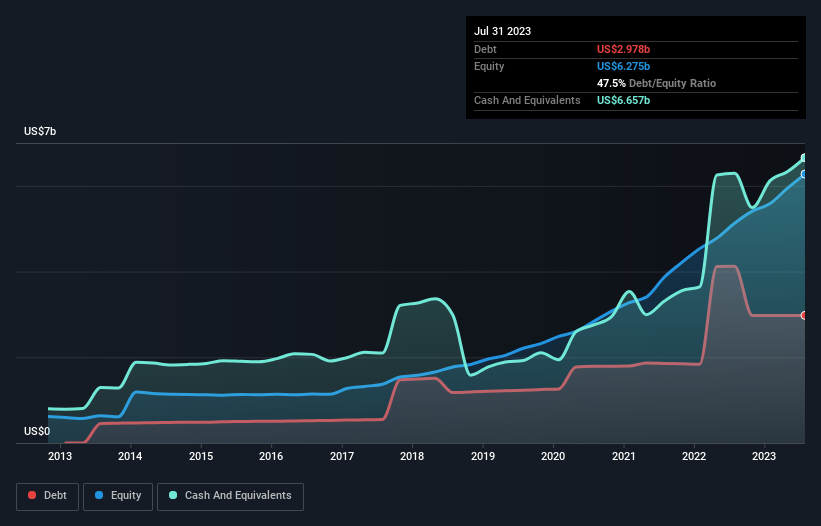
Some say volatility, rather than debt, is the best way to think about risk as an investor, but Warren Buffett famously said that 'Volatility is far from synonymous with risk.' When we think about how risky a company is, we always like to look at its use of debt, since debt overload can lead to ruin. We note that Workday, Inc. (NASDAQ:WDAY) does have debt on its balance sheet. But should shareholders be worried about its use of debt?
When Is Debt Dangerous?
Debt assists a business until the business has trouble paying it off, either with new capital or with free cash flow. In the worst case scenario, a company can go bankrupt if it cannot pay its creditors. While that is not too common, we often do see indebted companies permanently diluting shareholders because lenders force them to raise capital at a distressed price. Of course, debt can be an important tool in businesses, particularly capital heavy businesses. When we examine debt levels, we first consider both cash and debt levels, together.
See our latest analysis for Workday
How Much Debt Does Workday Carry?
As you can see below, Workday had US$2.98b of debt at July 2023, down from US$4.12b a year prior. However, it does have US$6.66b in cash offsetting this, leading to net cash of US$3.68b.

A Look At Workday's Liabilities
Zooming in on the latest balance sheet data, we can see that Workday had liabilities of US$4.18b due within 12 months and liabilities of US$3.28b due beyond that. Offsetting this, it had US$6.66b in cash and US$1.27b in receivables that were due within 12 months. So it can boast US$467.3m more liquid assets than total liabilities.
Having regard to Workday's size, it seems that its liquid assets are well balanced with its total liabilities. So it's very unlikely that the US$65.1b company is short on cash, but still worth keeping an eye on the balance sheet. Simply put, the fact that Workday has more cash than debt is arguably a good indication that it can manage its debt safely. There's no doubt that we learn most about debt from the balance sheet. But it is future earnings, more than anything, that will determine Workday's ability to maintain a healthy balance sheet going forward. So if you want to see what the professionals think, you might find this free report on analyst profit forecasts to be interesting.
In the last year Workday wasn't profitable at an EBIT level, but managed to grow its revenue by 18%, to US$6.7b. We usually like to see faster growth from unprofitable companies, but each to their own.
So How Risky Is Workday?
While Workday lost money on an earnings before interest and tax (EBIT) level, it actually generated positive free cash flow US$1.5b. So taking that on face value, and considering the net cash situation, we don't think that the stock is too risky in the near term. We'll feel more comfortable with the stock once EBIT is positive, given the lacklustre revenue growth. There's no doubt that we learn most about debt from the balance sheet. However, not all investment risk resides within the balance sheet - far from it. Case in point: We've spotted 2 warning signs for Workday you should be aware of.
If, after all that, you're more interested in a fast growing company with a rock-solid balance sheet, then check out our list of net cash growth stocks without delay.
Valuation is complex, but we're here to simplify it.
Discover if Workday might be undervalued or overvalued with our detailed analysis, featuring fair value estimates, potential risks, dividends, insider trades, and its financial condition.
Access Free AnalysisHave feedback on this article? Concerned about the content? Get in touch with us directly. Alternatively, email editorial-team (at) simplywallst.com.
This article by Simply Wall St is general in nature. We provide commentary based on historical data and analyst forecasts only using an unbiased methodology and our articles are not intended to be financial advice. It does not constitute a recommendation to buy or sell any stock, and does not take account of your objectives, or your financial situation. We aim to bring you long-term focused analysis driven by fundamental data. Note that our analysis may not factor in the latest price-sensitive company announcements or qualitative material. Simply Wall St has no position in any stocks mentioned.
About NasdaqGS:WDAY
Workday
Provides enterprise cloud applications in the United States and internationally.
Flawless balance sheet and good value.


